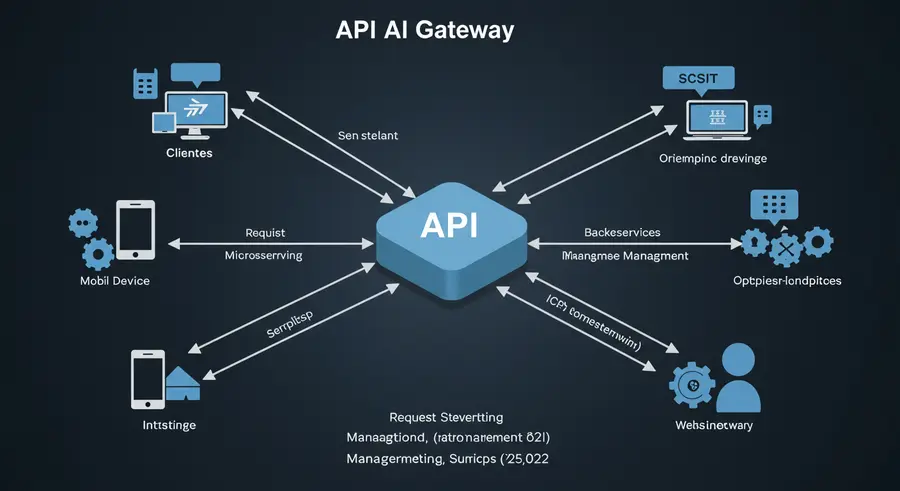Appearance

Welcome, fellow developers and tech enthusiasts! 👋 Today, we're diving deep into a crucial component of modern software architectures: the API Gateway. If you've been working with microservices, or even just exploring scalable web applications, you've likely encountered this term. But what exactly is an API Gateway, and why has it become so indispensable? Let's unravel its mysteries!
What is an API Gateway? 🤔
At its core, an API Gateway acts as a single entry point for all client requests into a system. Think of it as the ultimate traffic controller for your APIs. Instead of clients directly interacting with a multitude of backend services, they communicate with the API Gateway, which then intelligently routes their requests to the appropriate service.
In a world dominated by microservices, where applications are broken down into smaller, independent services, managing communication can become complex. This is precisely where an API Gateway shines! It sits between the client (e.g., a mobile app, a web browser, or another service) and your backend services, handling a variety of cross-cutting concerns.
Why Do We Need API Gateways? The Benefits Unpacked 🚀
The adoption of API Gateways isn't just a trend; it's a strategic move that brings numerous advantages:
- Simplified Client-Side Complexity: Clients no longer need to know the individual addresses or intricacies of each microservice. They interact with a single, consistent endpoint, simplifying their code and reducing development overhead.
- Centralized Request Handling: The Gateway can handle common functionalities like authentication, authorization, rate limiting, and logging in one place, preventing repetitive code across multiple services.
- Enhanced Security: By acting as a shield, the API Gateway protects your backend services from direct exposure to the internet, filtering malicious requests and enforcing security policies.
- Improved Performance and Scalability: It can aggregate multiple requests into a single call, reducing network round trips and improving overall application performance. It also facilitates scaling individual services independently.
- Flexibility and Agility: Changes to backend services don't necessarily impact client applications, as the API Gateway abstracts these details. This allows for faster development cycles and easier evolution of your services.
- Monitoring and Analytics: API Gateways provide a central point for monitoring API traffic, performance metrics, and error rates, offering valuable insights into your system's health.
Key Functionalities and Common Patterns 🛠️
An API Gateway is far more than just a proxy. Here are some of its critical functionalities:
- Request Routing: Directs incoming requests to the correct backend service based on predefined rules.
- Authentication and Authorization: Verifies client identities and permissions before forwarding requests. This might involve integrating with OAuth2, JWT, or API keys.
- Rate Limiting: Controls the number of requests a client can make within a certain timeframe, preventing abuse and ensuring fair usage.
- Load Balancing: Distributes incoming traffic across multiple instances of a service to ensure high availability and optimal performance.
- Request/Response Transformation: Modifies incoming requests or outgoing responses to match the expectations of clients or backend services. This can include data format conversions (e.g., XML to JSON).
- Circuit Breaking: Prevents cascading failures by detecting failing services and temporarily preventing requests from being sent to them.
- Logging and Monitoring: Collects data on API usage, errors, and performance, providing valuable insights for operational teams.
- API Composition/Aggregation: Combines responses from multiple backend services into a single response for the client.
Security Best Practices for API Gateways 🛡️
Given its critical role, securing your API Gateway is paramount. Here are some best practices:
- Use Modern Authentication Methods: Implement robust authentication mechanisms like OAuth 2.0, OpenID Connect, and JWT.
- Input Validation: Validate all incoming requests rigorously to prevent injection attacks (SQL injection, XSS) and other common vulnerabilities.
- Rate Limiting and Throttling: Protect against Denial-of-Service (DoS) attacks and prevent API abuse by setting appropriate rate limits.
- HTTPS Everywhere: Enforce HTTPS for all communication between clients and the API Gateway, and between the Gateway and backend services, to encrypt data in transit.
- Web Application Firewall (WAF): Deploy a WAF in front of your API Gateway to detect and block common web exploits.
- Centralized Logging and Monitoring: Implement comprehensive logging and monitoring to detect suspicious activities and respond to security incidents promptly.
- Regular Security Audits: Conduct regular security audits and penetration testing to identify and address vulnerabilities.
- Least Privilege Principle: Grant only the necessary permissions to the API Gateway and its underlying services.
API Gateways in Action: Real-World Scenarios 🌐
- Microservices Architectures: This is perhaps the most common use case, where the API Gateway provides a unified façade over a complex landscape of microservices.
- Mobile Backend for Frontend (BFF): A specific type of API Gateway tailored to the needs of a particular client (e.g., a mobile app), optimizing the API for that client.
- Legacy System Integration: Bridging modern applications with older, monolithic systems by providing a consistent API layer.
- Public APIs: Exposing a set of APIs to external developers while controlling access and ensuring security.
Explore More on API Gateways! 📚
To delve deeper into the technical aspects and various implementations of API Gateways, be sure to check out our comprehensive resource on the topic:
👉 The Ins and Outs of API Gateways
The API Gateway is a powerful tool that simplifies, secures, and optimizes communication in distributed systems. By understanding its role and implementing best practices, you can build more resilient, scalable, and manageable applications.
Happy coding! ✨